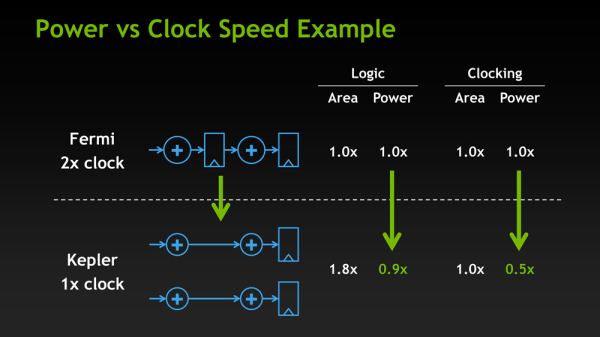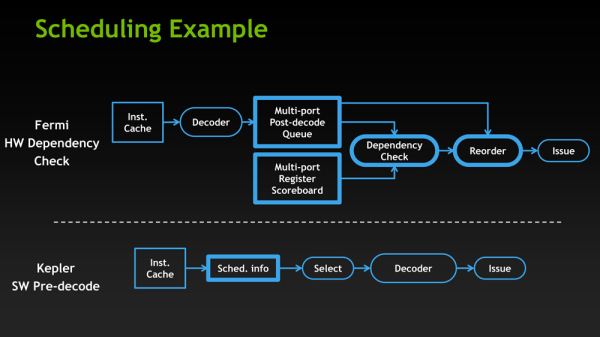NVIDIA GeForce GTX 680 Review: Retaking The Performance Crown
by Ryan Smith on March 22, 2012 9:00 AM ESTThe Kepler Architecture: Efficiency & Scheduling
So far we’ve covered how NVIDIA has improved upon Fermi for; now let’s talk about why.
Mentioned quickly in our introduction, NVIDIA’s big push with Kepler is efficiency. Of course Kepler needs to be faster (it always needs to be faster), but at the same time the market is making a gradual shift towards higher efficiency products. On the desktop side of matters GPUs have more or less reached their limits as far as total power consumption goes, while in the mobile space products such as Ultrabooks demand GPUs that can match the low power consumption and heat dissipation levels these devices were built around. And while strictly speaking NVIDIA’s GPUs haven’t been inefficient, AMD has held an edge on performance per mm2 for quite some time, so there’s clear room for improvement.
In keeping with that ideal, for Kepler NVIDIA has chosen to focus on ways they can improve Fermi’s efficiency. As NVIDIA's VP of GPU Engineering, Jonah Alben puts it, “[we’ve] already built it, now let's build it better.”
There are numerous small changes in Kepler that reflect that goal, but of course the biggest change there was the removal of the shader clock in favor of wider functional units in order to execute a whole warp over a single clock cycle. The rationale for which is actually rather straightforward: a shader clock made sense when clockspeeds were low and die space was at a premium, but now with increasingly small fabrication processes this has flipped. As we have become familiar with in the CPU space over the last decade, higher clockspeeds become increasingly expensive until you reach a point where they’re too expensive – a point where just distributing that clock takes a fair bit of power on its own, not to mention the difficulty and expense of building functional units that will operate at those speeds.
With Kepler the cost of having a shader clock has finally become too much, leading NVIDIA to make the shift to a single clock. By NVIDIA’s own numbers, Kepler’s design shift saves power even if NVIDIA has to operate functional units that are twice as large. 2 Kepler CUDA cores consume 90% of the power of a single Fermi CUDA core, while the reduction in power consumption for the clock itself is far more dramatic, with clock power consumption having been reduced by 50%.
Of course as NVIDIA’s own slide clearly points out, this is a true tradeoff. NVIDIA gains on power efficiency, but they lose on area efficiency as 2 Kepler CUDA cores take up more space than a single Fermi CUDA core even though the individual Kepler CUDA cores are smaller. So how did NVIDIA pay for their new die size penalty?
Obviously 28nm plays a significant part of that, but even then the reduction in feature size from moving to TSMC’s 28nm process is less than 50%; this isn’t enough to pack 1536 CUDA cores into less space than what previously held 384. As it turns out not only did NVIDIA need to work on power efficiency to make Kepler work, but they needed to work on area efficiency. There are a few small design choices that save space, such as using 8 SMXes instead of 16 smaller SMXes, but along with dropping the shader clock NVIDIA made one other change to improve both power and area efficiency: scheduling.
GF114, owing to its heritage as a compute GPU, had a rather complex scheduler. Fermi GPUs not only did basic scheduling in hardware such as register scoreboarding (keeping track of warps waiting on memory accesses and other long latency operations) and choosing the next warp from the pool to execute, but Fermi was also responsible for scheduling instructions within the warps themselves. While hardware scheduling of this nature is not difficult, it is relatively expensive on both a power and area efficiency basis as it requires implementing a complex hardware block to do dependency checking and prevent other types of data hazards. And since GK104 was to have 32 of these complex hardware schedulers, the scheduling system was reevaluated based on area and power efficiency, and eventually stripped down.
The end result is an interesting one, if only because by conventional standards it’s going in reverse. With GK104 NVIDIA is going back to static scheduling. Traditionally, processors have started with static scheduling and then moved to hardware scheduling as both software and hardware complexity has increased. Hardware instruction scheduling allows the processor to schedule instructions in the most efficient manner in real time as conditions permit, as opposed to strictly following the order of the code itself regardless of the code’s efficiency. This in turn improves the performance of the processor.
However based on their own internal research and simulations, in their search for efficiency NVIDIA found that hardware scheduling was consuming a fair bit of power and area for few benefits. In particular, since Kepler’s math pipeline has a fixed latency, hardware scheduling of the instruction inside of a warp was redundant since the compiler already knew the latency of each math instruction it issued. So NVIDIA has replaced Fermi’s complex scheduler with a far simpler scheduler that still uses scoreboarding and other methods for inter-warp scheduling, but moves the scheduling of instructions in a warp into NVIDIA’s compiler. In essence it’s a return to static scheduling.
Ultimately it remains to be seen just what the impact of this move will be. Hardware scheduling makes all the sense in the world for complex compute applications, which is a big reason why Fermi had hardware scheduling in the first place, and for that matter why AMD moved to hardware scheduling with GCN. At the same time however when it comes to graphics workloads even complex shader programs are simple relative to complex compute applications, so it’s not at all clear that this will have a significant impact on graphics performance, and indeed if it did have a significant impact on graphics performance we can’t imagine NVIDIA would go this way.
What is clear at this time though is that NVIDIA is pitching GTX 680 specifically for consumer graphics while downplaying compute, which says a lot right there. Given their call for efficiency and how some of Fermi’s compute capabilities were already stripped for GF114, this does read like an attempt to further strip compute capabilities from their consumer GPUs in order to boost efficiency. Amusingly, whereas AMD seems to have moved closer to Fermi with GCN by adding compute performance, NVIDIA seems to have moved closer to Cayman with Kepler by taking it away.
With that said, in discussing Kepler with NVIDIA’s Jonah Alben, one thing that was made clear is that NVIDIA does consider this the better way to go. They’re pleased with the performance and efficiency they’re getting out of software scheduling, going so far to say that had they known what they know now about software versus hardware scheduling, they would have done Fermi differently. But whether this only applies to consumer GPUs or if it will apply to Big Kepler too remains to be seen.












404 Comments
View All Comments
_vor_ - Tuesday, March 27, 2012 - link
All I read is blah blah blah NVIDIA blah blah nerdrage blah blah.CeriseCogburn - Tuesday, March 27, 2012 - link
I'll translate for the special people that need more help.AMD's IQ has been bad since 5000 series, with 6000 series also screwey.
You will have shimmering in game textures and lines in shading transitions on screen since their algorithm has been messed up for years, even though it is angle independent and a perfect circle, IT SUCKS in real life - aka gaming.
Nvidia doesn't have this problem, and hasn't had it since before the 5000 series amd cards.
AMD's 7000 series tries once again to fix the ongoing issues, but fails in at least 2 known places, having only Dx9 support, but may have the shimmering and shading finally tackled and up to Nvidia quality, at least in one synthetic check.
_vor_ - Tuesday, March 27, 2012 - link
How much is NVIDIA paying you to babysit this discussion and zealously post?"It's better to keep quiet and people think you are a fool, than to open your mouth and prove them right."
CeriseCogburn - Tuesday, March 27, 2012 - link
Words right from anandtechs articles, and second attack.A normal person would be thankful for the information.
CeriseCogburn - Tuesday, March 27, 2012 - link
Did you notice the Nvidia card won Civ5 by more than the amd did in Metro2033, but Civ5 is declared a tie, and well we know what everyone is claiming for Metro2033.I noticed that and thought it was quite interesting how that was accomplished.
BoFox - Monday, March 26, 2012 - link
AMD's angle-independent AF is still flawed in that it's not fully trilinear when it comes to high-frequency textures (noisy moire). You'd be seeing lines of transition when everything suddenly becomes a bit blurry in a distance with these kinds of grainy textures.It's rather subjective, though.
Nvidia does offer up to 32x CSAA with TRAA (transparent, or alpha textures) in DX10/11 games for superb IQ without having to use brute-force SSAA. AMD does not currently support "forced" AAA (Adaptive AA) on alpha textures in DX10/11 games, and the SSAA support in DX10/11 games was finally announced in beta driver support form with HD 7970 cards.
Transparency AA has been around since 2005, and Nvidia actually maintained the quality IQ options for DX10/11 games compared to DX9 games all along.
ati666 - Monday, March 26, 2012 - link
did AMD fix this problem in their HD7970 or not?CeriseCogburn - Tuesday, March 27, 2012 - link
We will find out what's wrong with it a year from now when the next series big 8000 is launched, until then denials and claims it's as good as nvidia are standard operating procedure, and spinning useless theoretical notions that affect gameplay exactly zero and have amd IQ disadvantages will be spun in a good light for amd to get all the amd fans claiming the buzzwords are a win.That will work like it has for the last 3 releases, 4000, 5000, and 6000, and we just heard the 7000 series fixes that fix the 5000 and 6000 crud that was covered up until now in the 7970 release article.
So amd users will suffer bad IQ in several ways while buzzing up words that are spun from this website as notional greatness and perfectness of amd till like, next release... then your question will be answered - just try to not notice anything until then, ok ?
blanarahul - Saturday, March 24, 2012 - link
I was confused as to GPU Boost was necessary or not. Thanks for making the difference clear.ammyt - Saturday, March 24, 2012 - link
Dafuq y'all saying?The benchmarks are tight in front of your faces! The 680 is tied with the 7950, which surpasses it by a little, and the 7970 is the leader. The 7950 is cheaper by a little margin, but the 7970 is roughly $80 more expensive. What are y'all fighting for?
If I were to choose between the 680, 7950, 7970, I will choose the 7950, cheaper, and a faster by a little margin than the 680. I don't care how or why (memory clock, architecture, bla bla bla) but the benchmarks are in front of you! Clearly, anandtech is biased towards Nvidia.
(Perhaps they're getting paid from them more than AMD...)